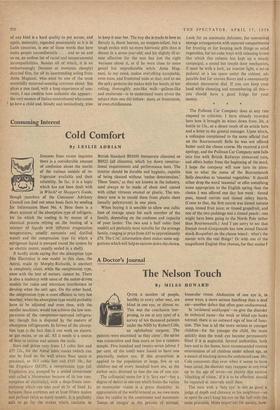A Doctor's Journal
The Nelson Touch
By MILES HOWARD The colloquial name for it is 'lazy eye'—but a degree of defect in one eye which limits the victim to monocular vision is a grave disability. In appreciation of the world around us, we owe more than we realise to the continuous and automatic 'fusion of images' in the process of normal, binocular vision. Abdication of one eye is, in some ways, a more serious handicap than a deaf ear—another defect that often goes undiscovered.
In 'unilateral amblyopia'—to give the disorder its technical name—the weak or blind eye looks normal; there is no outward sign of loss of func- tion. This loss is all the more serious in younger children—for the younger the child, the more quickly does the weak eye become permanently blind if it is neglected. Several authorities, both here and in the States, have recommended routine examination of all children under school age, as a means of tracking down the undetected case. Mr. Cole comments that even when it seems to have been cured, the disorder may reappear at any time up to the age of seven—so plainly this routine `checking of vision,' if it is to be effective, should be repeated at intervals until then.
The man with a 'lazy eye' is not as good a judge of depth and distance as his neighbour—so in sport he can't keep his eye on the ball with the same precision. More important for society, how- ever, is the monocular motorist—cars and people coming up on the amblyopic side tend to be invisible, until. they enter the visual field of the good eye. The American Medical Association's advice on this point has been accepted, so that now Some categories of heavy-lorry drivers in the US are obliged to undergo tests of vision. How much death and damage in this country, I wonder, could be avoided by similar tests—not only of lorry drivers, but everyone who applies for a licence?
Treatment of the disorder is practicable only in early life, and if one child in every twenty has it, the administrative task thus set to the Ministry of Health is formidable indeed. But, as my Com- mandant in the Brigade remarked to me twenty years ago, with a soldierly twinkle, 'Difficulties are made to be overcome.' This one is yet another challenge to the Top People whose job it is to care for the nation's health.
* * *
At a time when the focus of attention is moving away from drug and physic, and towards the emotional forces and 'pressures' in the relation of doctor and patient, it is useful to have a brief historical note on the subject, and this has recently been obligingly provided by three American doctors. Their paper contains a table showing 'three basic models of the physician-patient relationship' :
Model Physician's Patient's Prototype role role
1. Activity- Does some- Recipient Parent-infant
passivity thing to patient Tells patient Co-operator Parent- what to do Helps patient Participant Adult-adult to help himself
In his fear of helplessness, sickness and death, man has tried to master Nature by a variety of means, ranging from magic to the rationality of science. The earliest healers were magicians; medicine of the present day should adopt the third of these three models, in which the patient is an active participant in his own therapy. A glance around the contemporary scene will leave no doubt that Model Three is far from universal. And indeed, reflecting on it, I wonder if Model Three is after all the best for everyone? Don't we all want a bit of magic when we're ill? An over-rational approach is chilly and rather sterile. I suppose the ideal family doctor is he who knows his medicine, but knows too how to cast a benign spell. So much goes on in the human interactions of surgery and consulting-room that isn't put into words, or 'rational,' but is the influence of one per- son's moods and attitude upon another. To take one example only : the decision to retire. Suppose a man in his late fifties has been ill for a year or two, is tired and discouraged, and thinks about resigning. If the doctor caring for him is sanguine in outlook, urges him to go on trying, 'feeds' him, so to say, with drive—then he is likely to go on longer, and perhaps in the end gets over his ill- ness. If, on the other hand, the doctor tends to depression himself and is fatalistic, he may, in all good faith, counsel his patient to give up and go home. The decision here is not, strictly speaking, based on a reasonable assessment of facts, but on an emotional interchange which may not be with- in the 'perimeter' of consciousness in either party; yet it is this which in the end tips the scale one way or the other. 2.. Guidance- co-opera- tion 3. Mutual participa- tion
(obeys) adolescent



































 Previous page
Previous page